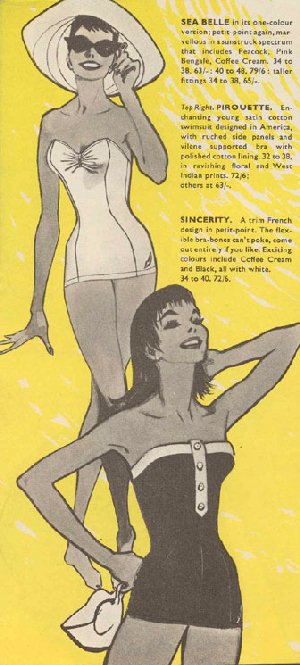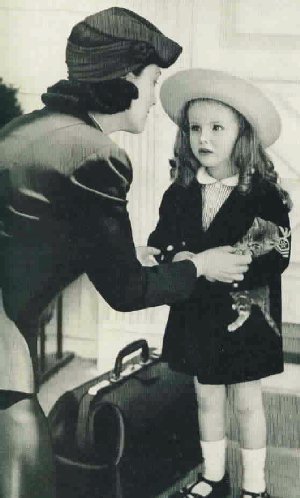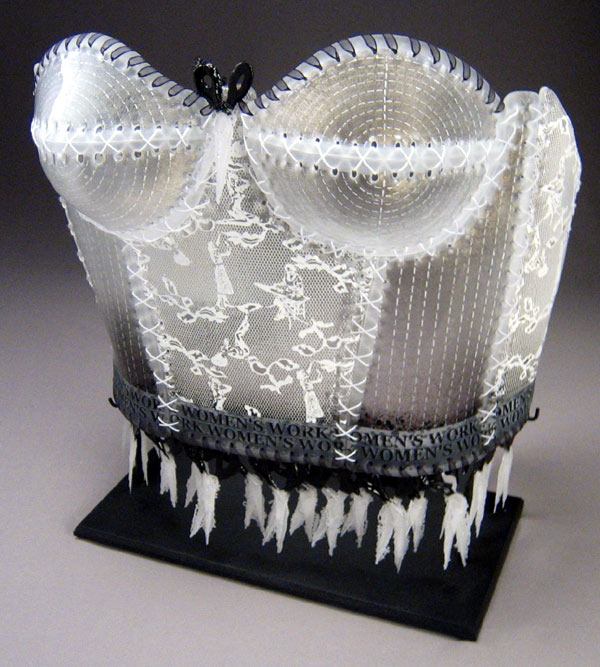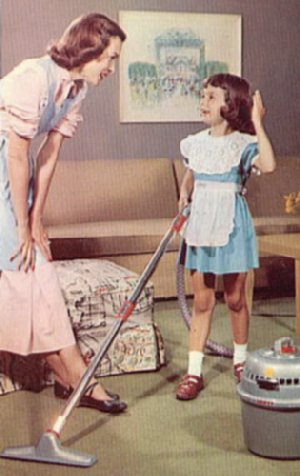 |
|||||
|
Monstrous Domesticity
Monstrous Domesticity
The rooms differ so completely; they are calm or thunderous; open on to the sea, or, on the contrary, give on to a prison yard; are hung with washing; or alive with opals and silks; are hard as horsehair or soft as feathers--one has only to go into any room in any street for the whole of that extremely complex force of femininity to fly in one's face. How should it be otherwise? For women have sat indoors all these millions of years, so that by this time the very walls are permeated by their creative force, which has, indeed, so overcharged the capacity of bricks and mortar that it must needs harness itself to pens and brushes and business and politics. But this creative power differs greatly from the creative power of men. And one must conclude that it would be a thousand pities if it were hindered or wasted, for it was won by centuries of the most drastic discipline, and there is nothing to take its place. - Virginia Woolf, A Room of One's Own, l929. To know the history of embroidery is to know the history of women. - Rozsika Parker, The Subversive Stitch, l984. The regrown limb can be monstrous, duplicated, potent. We have all been injured, profoundly. We require regeneration, not rebirth, and the possibilities for our reconstitution include the utopian dream of the hope for a monstrous world without gender. - Donna Haraway, Simians, Cyborgs, and Women, l991. 1. On a recent visit to my mother, we sat on the couch together talking as she knitted a sweater for my 7-year-old nephew. She complained about her arthritis which was making it increasingly difficult for her to knit. As I watched her, my hands began to itch to knit. She offered to let me finish the sleeve, and I eagerly took it up and began to knit -- for the first time in at least ten years. It was as easy as pie: the rhythms and movements of the fingers, the method of keeping the right tension, the techniques of increasing and decreasing stitches, the magic of looping a thread around steel needles and producing a fabric - all came back to me. My pleasure in practicing this long dormant skill was so great, that I forgot to count the pattern rows and soon had produced a monstrous sleeve twice as long as the other. It was this "potent limb" which suggested some of the lines of thinking I will follow in this essay.
2. It seems all too likely that only in a feminist art world will there be a chance for the "fine" arts, the "minor" arts, "crafts," and hobby circuits to meet and to develop an art of making with a new and revitalized communicative function....Visual consciousness raising, concerned as it is now with female imagery and, increasingly, with female process, still has a long way to go before our visions are sufficiently cleared to see all the arts of making as equal products of a creative impulse which is as socially determined as it is personally necessary; before the idea is no longer to make nothings into somethings, but to transform and give meaning to all things. In this utopian realm, Good Taste will not be standardized in museums, but will vary from place to place, from home to home. (Lucy Lippard, "Making Something from Nothing" Heresies #4, l978) In February l995 the Bronx Museum of the Arts mounted Division of Labor: "Women's Work" in Contemporary Art 1; a roughly chronological survey, starting in l962 and ending in the early 90s, which examined "artistic production as a gendered practice, and its relationship to a shifting discourse on gender stereotypes and roles within the domestic sphere." 2 When the exhibition's curator, Lydia Yee, asked me to recreate the room-sized crocheted environment I had originally made for Womanhouse in l971, I was very hesitant at first. The historicizing of 70s feminist art is currently arousing much debate, especially as it relates to what has been deemed the "return" to certain 70s artistic practices, processes, and subject matter, by both female and male artists in the 90s.3. In the past twenty years I have experienced the jolting ups and downs of a heritage of having come of age as an artist and feminist simultaneously, and being identified as one of the founders of feminist art practice in California in the early 70s -- for much of the work done by feminists in the 70s has been criticized as reinforcing an "essentialist" view of women. Thus I was reluctant to re-create a piece (in a very different context) which might be falsely interpreted as an uncritical celebration of women's traditional culture and handicrafts. As a practicing artist and activist feminist, my art work and thinking have been in constant flux. I have been influenced as much by my historical, critical, and theoretical research, as by the thorough training in skills and techniques which I had as a child. My work has also been informedby my teaching, and my participation in various cultural, political, and social movements since the 60s. In the 70s, I worked in media and forms which grew directly out of the discourses of feminism and 60s avant-garde art practices -- performance, environments, collaboration, mixed media, street works, and the like. I also consciously re-worked craft processes which I had learned as a girl growing up in a self-sufficient commune in Paraguay -- crocheting, weaving, knitting, embroidery, basketry, ceramics, leatherwork, and woodwork. Needles and thread and bread dough have done more for preserving nations than bullets, and women who made homes on the prairie, working valiantly with meager tools at their command, did more than any other group in settling the West. (Edith Kohl, Land of the Burnt Thigh p.287) When I made my original crocheted environment for Womanhouse in l971, I was motivated by my research on women's work and lives in various cultures. I found that women's work of making homes and domestic environments has been pivotal (though largely unacknowledged) in the major cultural inventions of civilization. The transformation of "natural" materials by human activity -- variously called "work", "craft", or "art"-- has been practiced since the beginning of human history for at least two reasons -- necessity (usefulness), and pleasure (uselessness). One distinction usually made between "craft" and "art" is that of usefulness (necessity) and uselessness (pleasure). Craft is generally thought of as unalienated (autonomous) work as opposed to the irksome, forced, necessity of labor, while art is related to nonrational work-as-play. Yet, as everyone who has made things knows, this binary is a false one; work, craft, and art, are intertwined in complex ways which reflect actual lived experience in which the mundane (rational) is constantly inflected by the transcendent (nonrational). The division of labor not only divides work up by gender and class, but it also separates the pleasurable and necessary aspects of work itself. In Western patriarchal culture (where binaries rule) domestic craft came to be associated with femininity, and high art with masculinity. In my crocheted environment, I wanted to pay homage to women's useful economic and cultural work, while at the same time producing a piece that was useless (non-practical) to demonstrate the falseness of the traditional distinctions between art and craft. As Virginia Woolf points out in the quote which begins this essay, women's creative capacities -- honed by "drastic discipline" -- have been squandered culturally by the restrictions of separate spheres (division of labor), which condemned middle and upper-class women to countless hours of "fancy work" or "home-decorating" ( work which was not taken seriously); while working-class women were exploited in tedious, alienated labor (work which men often refused to do) for which they were paid far less than men. Obviously, an account of the history of women's work is beyond the scope of this essay, but female labor and the "feminization of labor" are crucial global issues today, and it is no accident that they should appear as important subject matter in contemporary cultural production. As a teacher, I have repeatedly seen female (and, increasingly, male) students revisit the gendered processes of "women's work" as a way of connecting to a history of skilled production, of making -- and feeling (experience) -- which is all but absent from their lives. These students -- often daughters and sons of mothers who work outside the home and do not practice "home-making" -- usually have no traditional domestic craft skills such as sewing, crocheting, knitting, or cooking, but they evince a strong desire to make objects and/or place them in spaces which invoke domesticity with all its attendant meanings and feelings. In a way, what they are representing in this work is a certain loss, the absence of something to which they no longer have the connection of lived experience. It is important for students to know the lineage of "women's work", and to be familiar with the excellent scholarship which has emerged from several decades of feminist art history and critical theory. It was largely for this reason, that I agreed to reproduce the "Womb Room", for little of the actual "women's work" of the 70s has been seen by younger artists working today. Except for the Bronx Museum show, there have been no major historical surveys of this work, nor are there any significant museum collections of it. Womanhouse was demolished shortly after its exhibition in l972. Many other important works of the 70s have not been publicly exhibited at all, or not for many years. For example, Mimi Smith's Kitchen (l973) -- a work which looks highly contemporary and is every bit as complex and accomplished as a Sol Lewitt wall drawing (although it has a very different aesthetic origin and emotional content) -- was only shown by a museum for the first time in l994. Mary Kelly's pivotal work, Post -Partum Document (l974), has been shown in its entirety in the USA only once. 4 Institutional preservation of such work is important for reasons of history, pedagogy, and access. Though some of the work loses force and meaning when divorced from its original context (this is certainly true for the re-creations of the rooms from Womanhouse) it gains a different legitimacy and re-enters the discourse in a new way. By bringing together signal works from the 70s, 80s, and 90s, Division of Labor encouraged a re-examination of the history of gendered art practices, and a contextualized critique of the 90s return to the processes, spaces, and subject matter of domestic craft and women's work. 3. ....my own artwork addresses the issues of traditional women's handicraft and "sensibilities" in the context of mainstream cultural concerns.... Through my choice of a construction technique (crocheting) that is considered a traditional women's handicraft, this work confronts issues of choice and privilege, as my access to techniques is no longer limited to traditional women's work. The feminine and the masculine are combined and constructed into objects that comment on identity, relationships and beauty. Additionally, the transcendental nature of the repetitive process of crocheting brings many questions to mind regarding what has been shared by generations of women who silently participated in various states of altered consciousness through enactment of repetitive activity inherent in women's work. (Tracy Krumm, "The Heroine" p. 25, unpublished paper, l994) In The Subversive Stitch: Embroidery and the Making of the Feminine, Rozsika Parker outlines the historical connection between the rise of hierarchical divisions between art and craft and the creation of a code of femininity, " The development of an ideology of femininity coincided historically with the emergence of a clearly defined separation of art and craft." 5 She suggests further, that it is precisely because the needle arts are so entwined with the creation of femininity that they are so intractable to re-definition as art. Thus she concludes that the introduction of "craft" into fine arts (painting) has modified masculinity more than it has changed craft (femininity). Many of the avant-garde movements of the 20th century (Russian Constructivism, Dada, Surrealism) called for an end to the distinction between art and craft, thus opening up a space for women artists. However, since women artists in these movements often worked in "domestic" spaces (artisan workshops; handicrafts schools; designing embroidery patterns and fashions) rather than "high art" spaces (professional studios, art academies, museums), their work was usually not recognized as art, nor did the definitions of femininity and domesticity change -- even though some of the male artists became involved with craft processes.
|
|
||||
|
|
|||||
|
Postmodernities' boom in computer technology, virtual reality, and electronic communications, with its concomitant anxieties about the loss of the body and the "real" -- as well as profound global economic changes, changes in the nature of work, devastating biological viruses, and socio/political gender, race and class "trouble"' -- have contributed in l990s art practice (by both men and women) to a resurgence of work about gender and the body linked with domestic subject matter, processes, and craft techniques -- traditionally, women's work. Many artists are "returning" to feminist work of the 70s without really knowing they are doing so because so much of this early work entered the art mainstream, and was picked up by influential artists such as Mike Kelley, without acknowledgement of its sources. Much current installation art, as well as so-called pathetic and scatter art, mines the areas of the everyday and the contingent -- invoking tropes of home, family, illness, childhood, transitional objects, household detritus, clothing, bodily functions, victimization, love, loss, and the like -- in work that strongly recalls the look of much 70s feminist art. Feminist artists of the 70s set out to expose and reclaim the hidden histories of domesticity and women's lives; bringing them into public view in order to examine them, and to open up sites for critical interventions and new meanings. Some of this work attempted to rehabilitate areas of feeling (intimacy, the "sentimental" 6) and experience deemed exclusively "feminine"; but much of it was highly critical of the institution of the family, and of the restriction of women to the domestic sphere -- as well as questioning the division of labor, and the conditions of work itself. By contrast, much of the 90s art (by men and women alike) uses domestic tropes and gendered processes in works which tend to spectacularize, sentimentalize, pathologize, or aestheticize the domestic, rather than offering new critical insights. It must be noted that these artists are usually not working in the context of a strong socio/political movement such as the feminist movement of the 70s. Whereas when Duchamp placed a urinal in a museum as an art object it was not only an iconoclastic gesture, but could also be seen as a specifically masculine one (which Meret Oppenheim more than countered with her sly, supremely female, fur-lined teacup); in the 90s, it is by now a truism that the signifiers of femininity can be (and are) freely used in art (and sometimes life) by men, and that the signifiers of masculinity are similarly used by women. But a mere reversal of gender signifiers (while often funny and consciousness-raising) does not seem to be enough to get rid of gender roles and stereotypes -- or else we would have entered a non-gendered utopia long since. For example, Mike Kelley's reclaimed crocheted afghans, chewed toys, and cloth dolls, scattered about in the Whitney Museum, somehow do more to reify his bad boy masculinity, than to address or change the codes of gender. Kelley's work does not so much read "tough boys can be soft and play with dolls", as it proclaims "I'm such a tough guy -- even when I title a work Half a Man -- that I can appear pathetic and a failure by working with this stuff". The appropriation of traditionally female and domestic tropes by a famous white male in a retrospective museum show, effectively rehabilitates them for high art use (at least by men), but the connection to the feminist project which engendered this work is erased. As critic Terry Myers has written, "The overwhelming generative source for Mike Kelley's work--in historical, aesthetic, conceptual, visual, political, economic, and/or institutional terms -- is precisely the painting, sculpture,installation, video, performance, etc., that was made by women artists and art students in Southern California beginning in l970 (the year in which Judy Chicago began the Feminist Art Program...)"7 The enthusiastic reception of Kelley's work, and its considerable influence on younger artists, suggest that references to domesticity and traditionally female work are acceptable when presented as signifiers of the 'pathetic', 'abject', or 'failed'. These readings do not lead us back to the critical projects of feminism which include re-valuing "women's work" as necessary for cultural and economic survival (and therefore worthy of adequate remuneration), and uncoupling the gender codes of the division of labor. Important precursors to much of the signal art of the 70's were the works of Eva Hesse and Lee Bontecou. The hybridization of domestic and industrial (non-art) materials and processes used by both these artists, in works which speak of the replicable and fragmented body and psyche in the age of technological reproduction, were (and are) truly groundbreaking. Bontecou's wire-sutured, lead-bound vortexes lead into (or out of) the abyss of darkness. Hesse's meaningfilled repetitions suggest infininty in materiality. The combination of abstraction with obsessively repeated -- worked -- forms alluding to the body, machines, and nature, in both Hesse's and Bontecou's work, produces suggestive and "monstrous" (in Haraway's sense) new possibilities. This work represents new, non-gendered ways of figuring the truth about the body in postmodernity.
4.
Labor is blossoming or dancing where
The subject of work (labor) itself is central in much "domestic" artwork. This is often expressed in the charged, obsessional quality given to objects or installations which have been personally worked by the artist. This obsessional quality speaks about the body in time (a life-time), and ceaseless effort. The repetition of bodily gestures and motions produces sameness with slight variations (a mimicry of the conditions of every day life), and a hypnoid state (altered consciousness) in the maker. An epistemology of making develops, which brings into play knowledge lodged deeply in the interaction of hand and material: making fabric, making substance,transforming, linking stitch to stitch, loop to loop, fragment to fragment, forming a web, connecting strand to strand, node to node, repeating, patterning, alternating, repeating -- the magic of form coming into being through the "thinking hands" acting with material. The above could be a description of the processes of drawing, painting, crocheting, embroidering, weaving, and the like -- and even perhaps of (longhand) writing. Work which emerges from the desiring body (and affirms the body); which spins out from the laboring (female) body in crocheting, lace-making, knitting, weaving -- like a spider spinning webs out of her own body -- seems always to have aroused great anxiety in men. Why should this be? And why should drawing, writing, painting -- which also emerge from the body -- be considered superior (male) practices? Western philosophy posits that art, though grounded in materiality, transcends the every day (usefulness), and that its meaning outlives the body which produces it. "Domestic" handwork produces useful objects--which are usually as beautiful as the producer can make them -- objects which adorn and comfort the body, objects which make life possible. Yet these objects, like bodies, wear out in daily use --they are not immortal or transcendent. Thus they remind us of mortality, and they are regarded as lesser (less human) than art objects. This split reflects a culture which still fears the body (the female), and the life of the body --and which may be perversely embracing cyber technology precisely because it seems to vaporize and sanitize the body and distance mortality.
5. Contemporary artists who seek to address gendered work and the domestic in the 90s need to take into account recent economic, cultural, and sociological, developments, as well as considering how technological innovations are profoundly altering both public and private work and life globally. "Women's work", "feminized labor" and "the homework economy", are intimately entwined with the problems of the assault on poor women (and children) -- through the attacks on welfare, health care, public education, and abortion -- now going forward with such vindictiveness and cruelty in the United States Congress. Recently, Katha Pollitt called this assault the crucial issue for feminists, because the situation of poor women in the US as it now obtains, will increasingly be that of more and more people in the global technological society.8 Thus, ironically, "women's work" has once again become a central symbol and an image for the world-wide division between the wealthy and the poor, of those who have access and those who do not. In her influential essay "A Cyborg Manifesto", Donna Haraway sketches " one vision of women's 'place' in the integrated circuit" as seen from the point of view of advanced capitalism: "Home: Women-headed households, serial monogamy, flight of men, old women alone, technology of domestic work, paid homework, re-emergence of home sweat shops, home-based businesses and telecommuting, electronic cottage, urban homelessness, migration, module architecture, reinforced (simulated) nuclear family, intense domestic violence."9 In short, not a pretty picture -- and certainly not the one envisioned by utopian social activists and sexual liberationists of the 60s and 70s. 'Home' has always been a complex concept -- especially for women -- and one that appears to be ancient and inescapable, even mythic. As a newcomer to the Internet, I note the references to (virtual) domestic architecture, place and process: "World Wide Web", "home page", "domains", "windows" "netscape". The incommensurability of virtual space is made user-friendly by such allusive designations (since vehicles made for physical human travel have always been fitted out with domestic furniture and accouterments, why not our cyberconveyors?) Humans seem to need to carry home with them, to make themselves at home wherever they go. Without "home", it seems, there can be no life. "Home-making" has traditionally encompassed many skilled activities passed on from grandmother to mother to daughter. Cooking, sewing, knitting, washing, candlemaking, spinning, dyeing, gardening, weaving, nursing, food-preservation, making storage vessels, and the like, were usually skills which were taught one-on-one. Accompanying this teaching was a rich tapestry of stories, songs, poems, rituals and family history, anecdote, gossip, proverbs, recipes, riddles, spells, incantations, secrets, as well as a good measure of "women's" lore -- instruction in the codes and arts of femininity. The survival of skills (and the skills of survival) depends on a lineage of teaching and learning which has traditionally taken place in the private sphere, in the home. Today however, largely because of women's vastly increased roles as family breadwinners,10 the private home as a pedagogical site has increasingly been replaced by public institutions, especially schools. This means that "domestic" skills are now often not acquired at all by young children, or that they are learned in a "professionalized" and often depersonalized (though not a de-socialized) environment. On the one hand, this can have a liberating effect, as the acquisition of the skill or technique is not accompanied by the stultifying lessons of femininity. On the other hand, there is a loss of the context and culture, the history and content, the feeling of the skill -- part of which, as Rozsika Parker has demonstrated, is how skills have been used by women as secret weapons against their enforced domestic roles. Furthermore, the realms of public and private are undergoing a confusing and alarming shakeup and redefinition, largely to the detriment of both, and with the immediate result of reifying gender roles by intensifying the divisions of class, race, and sexual identities. Increased specialization of skills, consumerism, and a greater stratification in the division of labor, have also contributed to a general loss of widely practiced every-day survival and craft skills, and aconcomitant estrangement from unmediated sense experience.11 Under such conditions, these traditional "hand" skills are increasingly, and inappropriately, fetishized, and nostalgic sentiments are woven about them, which again separates them from every-day life. Domestic processes and subject matter have entered the mainstream of art and are used by men and women alike. In this metamorphosis a 'feminization' (but not a "feminism-ization") of the art-world is occurring, which parallels the feminization of popular culture. Art which explores "emotional" or "personal" (identity) themes and subjects, such as childhood, AIDS, cultural and ethnic difference, body art, clothing, love, loss, and sexual identity, is ubiquitous -- but it has done more to amplify notions of masculinity (men who knit) than abolishing connotations and definitions of femininity as lesser; nor has much improved in the opportunities for women artists. As the current Whitney Biennial attests, there is an effort being made to bring back painting at the expense of all the installation/political art at the previous Biennial. Work which serves as a critical and engaged vehicle for the examination of female experience, gender roles, and feminist analysis of women's lives and work, is seen more rarely. I shall discuss two contrasting examples of contemporary re-presentations of women's lives (both in the Bronx show) which draw on past feminist art making strategies, and which raise crucial issues about the "feminization of labor".
6. "In her performance and installation Hermes Mistress (l994-l995), Regina Frank succeeds in collapsing the distance between the managerial and labor aspects of post-industrial production. Wearing a beautiful red silk dress, Frank communicates on the Internet via modem, saving fragments of text on her Powerbook computer -- some of which the artist later painstakingly transcribes by hand-sewing tiny beads onto the dress." 12 Frank's piece engages contemporary issues of women's work, and the uses of old and new technologies, in complex ways. Visually, the work is a stunning spectacle. It replays the fairy-tale of the impossible task -- spinning straw into gold; sorting mountains of seeds; carrying water in a sieve -- given to beautiful girls, upon completion of which they will be freed from evil enchantments to marry handsome princes and live happily ever after. But the artist is already a princess, and a fashionable one at that -- as her high-heeled red shoes and handsome silk peignoir, shed carefully in the performance area, attest. Our eyes cannot help but follow her voyeuristically, as she slips into the monumental swirl of luxurious red silk dress, and jacks into the World Wide Web. The fairy-tales are a metaphor for women's never-ending task to render the mundane transcendent, and every day life comfortable and beautiful for others, and here she is doing it again. Visually, the piece also re-presents woman as the eternally immobile waiting one, the object of our gaze -- a cyborg mistress -- who wiles away her time piecing together an endless incantation (gleaned from texts gathered from the Internet) against annihilation and oblivion.13 Through the Net she has access to the world of thought, text, language, information. But it seems that this profits her no new way of being in the world as she still sits beautifully transfixed, sewing alphabet beads onto her silk dress. If she is a "manager", she is mainly managing her appearance (representation) as a beautiful woman, not her action in the world. Although the piece suggests interesting possibilities, to my mind, the hybridization it represents appears to reify, rather than question, women's traditional role and representation, and to offer a problematic promise of cybernetics as a liberation from the humdrum and limiting aspects of the experience of domestic life and work. On the other hand, it could be argued that the piece represents this cyborg mistress as a pleasure machine -- her own pleasure, as well as ours. A ghost lurks in this machine: the ghost of women's unseen (alienated) work in the global garment and electronics sweatshops -- the new "homework economy" 14 -- which parallels that of the domestic and factory sweatshop. Haraway points out that "women in Third World countries are the preferred labor force for science-based multinationals in the export-processing sectors, particularly in electronics." 15 Yet access to computers, the Internet, and advanced electronic communications and services is still largely restricted to First World businesses, academics, and middle class professionals and their kids, and electronic technology is still popularly regarded as a male province.16 Here then, we have the classically alienated position of women producing things which they themselves will never have access to buying or using. Frank's piece derives in part from her work as a seamstress making beautiful, precious garments for other women. Thus it also relates not incidentally to the fashion business, and by extension, to the global garment industry which is intensely stratified as to class, race, and gender, as well as being among the lowest paid "feminized labor". The use of large amounts of expensive silk fabric (Atlas silk) sets the wearer of this piece apart from the makers of this fabric -- the traditional prerogative of managers is that they get to dress better. The viewer becomes an envious voyeur of experiences which are not available to large numbers of people: access to the Internet; luxury materials; the freedom (leisure, money) to make/wear something beautiful and impractical. This piece aestheticizes and conceals the conditions of many contemporary women's lives and labor -- or evokes them only through absence. I miss a more activist and critical component to the work -- which could have been supplied by a different kind of performance of the text. But we read the text through the object of beauty offered to our gaze (we also hear/see her read it virtually, in a sing-song monotone, on a TV screen); it flows through her fingers onto the red silk. Thougha woman is mediating language here, she is not changing the codes of representation -- thus, she becomes again the mediator of someone else's text, not the generatrix of her own. Hermes' mistress serves time here as a silenced messenger of texts which cannot free her (or us) from the spell of enforced femininity and ceaseless labor. To be feminized means to be made extremely vulnerable; able to be disassembled, reassembled, exploited as a reserve labor force; seen less as workers than as servers; subjected to time arrangements on and off the paid job that makes a mockery of a limited work day; leading an existence that always borders on being obscene, out of place, and reducible to sex. (Donna Haraway,"A Cyborg Manifesto" l985) Lynne Yamamoto's installation Untitled, l993 (Wash House) uses a terse text consisting only of verbs inscribed on flat nailheads to drive home the story of her "picture bride" grandmother's backbreaking life of labor as a laundress on a sugar plantation in Hawaii.17 The verbs replay the monotony of female domestic labor: "cook", "clean", "iron", "wash", "scrub", "fold", as well as telling the secret story of female sorrow "worry", "love", "weep", which is also part of "women's work". The long row of nails on the wall creates an inexorable iron line of demarkation of experience from which there is no deviance. They are nails in the coffin of this stunted life which ends starkly in "drown". Here repetition is not an aesthetic device but rather a semiotic one, repetition is the meaning -- and the meaninglessness -- of this life. The relentless line of nails is an apt visual image for the "drastic discipline" Woolf speaks of. In the metaphor which encapsulates this particular life; in the spaces between the words; there is room to read the stories of countless other lives. While many of the words refer to gender-specific work, they also refer to the survival labor still performed in the USA by millions of immigrants of various races and classes (and by large numbers of the american working-class and poor) as well as poor people (both male and female) the world over. In her eloquent, yet unsentimental, work, Yamamoto reveals a biography of domestic and survival labor which has not vanished from the world in spite of major technological inventions. The piece offers hope in that it makes us conscious of the differences between two generations of women. The grand-daughter has become an artist who uses language as well as objects; she can give voice to a silenced past; she moves in a larger world where her work can contextualize and illuminate the lives of her foremothers; her work is not forced, not alienated, not bitter -- and she is using it to enlarge our understanding of the (needless) sacrifices of millions of lives.
7. The ideologically charged question of what counts as daily activity, as experience, can be approached by exploiting the cyborg image. Feminists have recently claimed that women are given to dailyness, that women more than men somehow sustain life, and so have a privileged epistemological position potentially. There is a compelling aspect to this claim, one that makes visible unvalued female activity and names it as the ground of life. But the ground of life? What about all the ignorance of women, all the exclusions and failures of knowledge and skill? What about men's access to daily competence, to knowing how to build things, to take them apart, to play? what about other embodiments? ..Race, gender, and capital require a cyborg theory of wholes and parts. (Donna Haraway, Simians, Cyborgs, and Women, pp.l80-l) In conclusion, I return to the monster sleeve I knitted in my mother's living room that winter afternoon in Vermont. I return to the crocheted "Womb Room" I re-created with two young women artists -- to whom I had just taught crocheting. Our hands moved surely, freely, playfully, wielding crochet hooks and looping Woolworth's cheapest 'Sweetheart' yarn to make a fanciful, airy, complex, webwork full of forms variously suggesting body parts, domestic furniture, pot-cloths, wash-cloths, sweaters, chandeliers, the Brooklyn bridge, stalactites, chains, grottoes, ladders, cells, umbilical cords, doilies, and lattices. The web invokes the experiences and objects of everyday life and work, yet it is visually abstracted into a three-dimensional "drawing" created by means of the simplest of "domestic" techniques. Because it can never be finished, it speaks of time and timelessness. Because it is "useless" and beautiful, it evokes feeling and the nonrational. Because it is made with cheap materials and easy to learn skills, it does not mystify the viewer. The process of its making provided other surprises, for while we crocheted we became inhabitants of the Museum and somewhat reshaped its daily "life" around our work. As we crocheted, we talked -- about our lives, our work, our bodies, computers, machines, feminism, politics, love, our mothers and our grandmothers. Museum workers and visitors stopped by to touch our work and marvel at the spinning forth of substance; they told us stories about their childhoods, their mothers, their families. We exchanged gifts of food, advice, friendship, and solidarity. Working together intimately in a public space connected us in new ways. It created an example of affinity based on unalienated, creative work. None of us lost our autonomy, yet we all learned from each other and made something more various and inventive than one individual could have made by herself. I do not wish to freight this work with too many interpretations, but to me it did become a suggestion of new possibilities for my own work, and for collaborations with others. While thousands in this country flock to Martha Stewart's "hyper-idealized version" of the simulated nuclear family, becoming devotees of her hyper-consumerized activities of "home-keeping" and "garden-keeping" which capitalize on the contemporary "need for balance, the sacredness of family rituals and holidays," 18 millions of poor workers (all over the world) sleep in shifts in bunk beds, crowded into dilapidated urban dormitories. Those of us who have the fortune to resist such sacrificial lives of repetitive, numbing toil, must strive to create new models for envisioning the pleasurable, non-gendered reconstitution of life and work. I suggest beginning with the lessons of the pleasure of libidinal making, the pleasure of daily competence, the pleasure of practicing skills for their own sake -- and for the sake of new inventions, new formations, new embodiments. Technology demands learning new skills, but let's not abandon all those we already know. Let's resist the coercion to over-specialize, to become mono-skilled, for then it is too easy to enslave us, or make us obsolete and redundant. Haraway suggests that it is through new combinations of the hand-made and the machine-made, new graftings, the re-generation of potent, aberrant limbs, that we will have to negotiate our way in the treacherous world of global economics and re-imagined (work) lives. Let us resist the harnessing of new technologies to old ideologies and mythologies which perpetuate gender roles, exploitive division of labor, and other stratifications. Hope lies in new practices of monstrous domesticity; of potent craft; harnessed to a vision of the re-generation of a home for all in the world. *Printed in M/E/A/N/I/N/G, #18, November, l995. New York Notes:
|
|||||
 |
|
 |
|||







